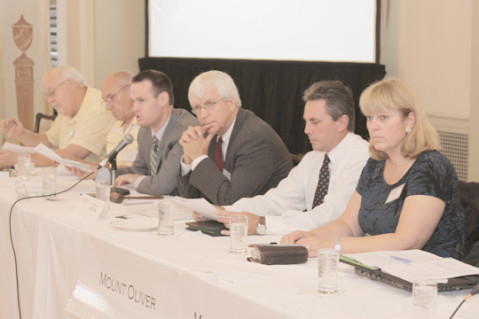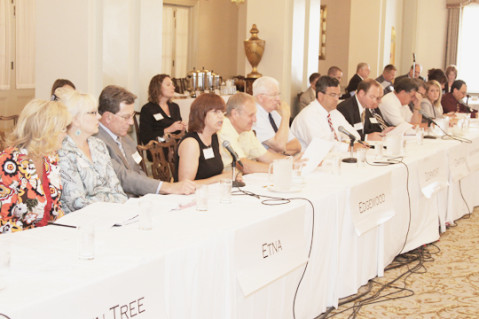Widgetized Section
Go to Admin » Appearance » Widgets » and move Gabfire Widget: Social into that MastheadOverlay zone
CONNECT Unites City and Suburbs
This article series is currently running
in the January/February 2011 print issue of PA TIMES. Contact Editor
Christine Jewett McCrehin ([email protected]) for more information on
how to receive the print issue.
Pittsburgh Organization Promotes Cooperation and Collaboration
David Y. Miller, Kristen Michaels
In the simplest terms, the Congress of Neighboring Communities, CONNECT is an organization that promotes cooperation and collaboration between the City of Pittsburgh and the 35 municipalities that share a common border with the City. Though the concept may sound basic, the very development of CONNECT is an innovation in regional governance with few, if any, counterparts.
The tension that exists between center cities and suburbs has been elevated in many circles to a status of “settled law” or “natural law.” To describe the relationship as contentious is usually followed with general nodding in quiet agreement and a fatalistic shrug of the shoulders. Although there is significant anecdotal information to suggest a measure of reality, it also makes the fallacious assumption that all suburbs think about their relation to the city in the same way and that cities think all suburbs are of equal importance. This vanilla approach to urban governing structures hides the potential opportunities for reframing our perceptions about how to address fragmentation in metropolitan regions.
The need to reframe how we organize our metropolitan regions has never been greater. A recent Brookings Institution report, “State of Metropolitan America: On the Front Lines of Demographic Transformation,” affirmed the need to bridge the gap between city and suburb: “Especially in light of the deep fiscal crisis facing states and local governments, the lines between cities and suburbs–and the long, fruitless history of battles and mistrust between them–must be transcended …” Similarly, in October 2009, The Washington Post reported, “The (Obama) administration plans to use federal grants to reward cities for cooperating with their suburban neighbors, which in many parts of the country are increasingly beset by traditionally urban problems such as crime, failing schools and declining neighborhoods.”
The bridge to such a reframing starts with the simple observation that municipalities that share a common border with a center city probably think about their relation with that city in very different ways than do municipalities further removed from that center city. One consequence of the movement of people away from center cities to suburbs has been the movement of urban issues to those municipalities most adjacent to the center city. As a result, municipalities that share a common border with a center city are looking more like neighborhoods in center cities such that our metropolitan urban cores could be better characterized as a collection of neighborhoods, some of which are located in a center city and some of which are in a contiguous municipality. Today’s urban cores are no longer just a center city, but a center city and those municipalities with which it shares a common border.
Consider the city of Pittsburgh in Allegheny County as an example. The city’s current population of 310,000 stands in stark contrast to its post WWII population of 660,000 even though the overall population of Allegheny County has remained at about 1.3 million during the same period. The bulk of the population has scattered into the 129 other municipalities that make up Allegheny County. Efforts to find common ground between the City and 129 municipalities has historically proved frustratingly fruitless and, sometimes, divisive and counter-productive.
However, of the 129 municipalities in the county, 35, with a combined population of 370,000, share a common border with the City. Consider those municipalities to be fundamentally different than the other 94 leads to some interesting insights. Together they form a contiguous urban core of 680,000. Thinking of those 36 municipalities as an urban core helps to focus on, not what separates city from suburb, but what unites those that live in the most urban of our metropolitan regions. For instance, together they make up 58 percent of the population of the county and 67 percent of the all the jobs in Allegheny County. Additionally, 75 percent of the county’s transit dependent population and over 90 percent of the activity of the public transit authority falls within its borders. About 80 percent of the county’s African-American population lives within its borders. Politically, it covers 13 of the 15 County Council Districts, 17 of the 23 State Legislative Districts in Allegheny County, and three of the five State Senate Districts.
Realizing the potential strength that could be harnessed by uniting this new urban core, in 2008 David Miller at the University of Pittsburgh Graduate School of Public and International Affairs convened what has become the Congress of Neighboring Communities (CONNECT). The first organization of its kind, CONNECT brings together elected and appointed officials from the City of Pittsburgh and the 35 municipalities that share its border to address common issues in an open forum where each municipality regardless of size, population, or any other factor has an equal say in forming the agenda and priorities of the organization.
CONNECT’s mission is to coordinate the activities of the city and these municipalities by advocating for and voicing the collective interests of the urban core and its 680,000 residents; developing and enhancing ways the 36 municipalities can work together to deliver important public services; and maintaining a forum for the discussion, deliberation, and implementation of new ways to maximize economic prosperity for Western Pennsylvania.
The CONNECT membership is comprised of three representatives from each member municipality, a representative of Allegheny County, and a handful of non-voting members including the Pittsburgh City Controller, and a representative of Allegheny County’s Department of Community and Economic Development. CONNECT is led by four elected officers, and the Executive Committee which is comprised of one representative from each municipality.
The Executive Committee has directed the work of the organization to tackle policy issues including emergency medical services funding, water/sewer management, transportation, blighted and abandoned property, and green initiatives. Policy working groups have been developed to further explore and develop solutions to each of the issues brought forth by the Executive Committee.
Though still in its nascent stage, CONNECT has already made significant progress. As of this year CONNECT has the participation of all of the 36 municipalities; has received grant funding to address sewer management issues in its municipalities; and has greatly increased the communication between its member municipalities.
Allegheny County is not the only heavily fragmented region in the state. The 10 older core cities in Pennsylvania (Allentown, Bethlehem, Easton, Erie, Harrisburg, Lancaster, Pittsburgh, Reading, Scranton, and York) have a combined population of 922,941. Collectively, they are surrounding by 97 municipalities with a combined population of 997,691. With this amount of people living in urban core areas, it is easy to see that the development of a shared agenda to solve common problems, and an organization to facilitate this work, could be a vital key to regional governance.
David Y. Miller, director, Center for Metropolitan Studies at the University of Pittsburgh Graduate School of Public and International Affairs. Email: [email protected]
Kristen Michaels, project coordinator, Congress of Neighboring Communities. Email: [email protected]







pram3010
February 16, 2016 at 2:22 am
Dear Expats, i am planning to move to Florida to study the suburb area of different states. Actually,I am a researcher & want to continue my research on suburbs people and the challenges to survivals. I want to know more about the culture, climate (in which they are residing), their ways of living, cost of living, structure of living, etc. Brief about myself, i am a student of PhD. from India & doing deep research on people living in suburbs of developed & developing countries. Guys, i have searched on internet too. found few sites like – http://www.microburbs.com.au but not found much relevant. guys suggest something better to proceed quickly on my research….. I am posting this topic here as a hope to get best guidance to go their in next 2 months & study the best results….Regards !